Hinges Around the Home
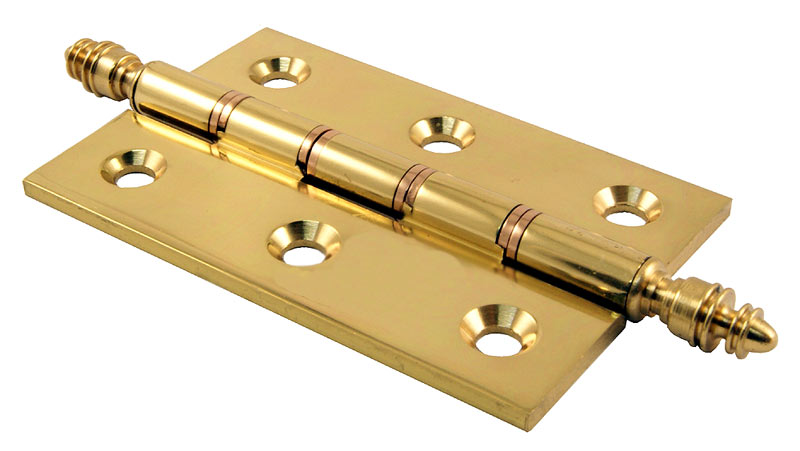
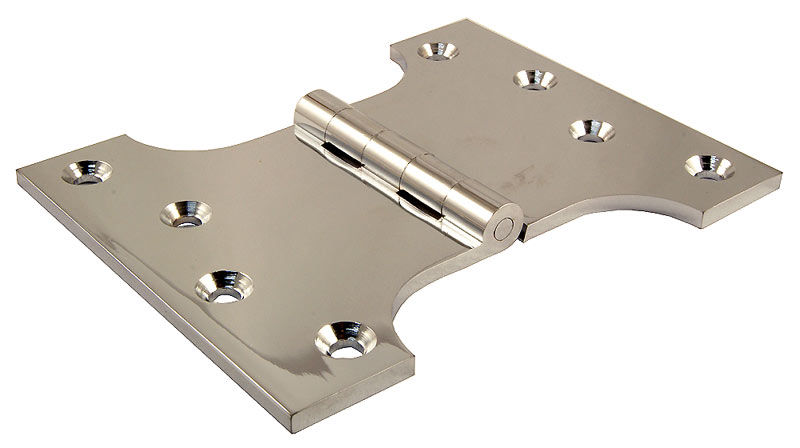
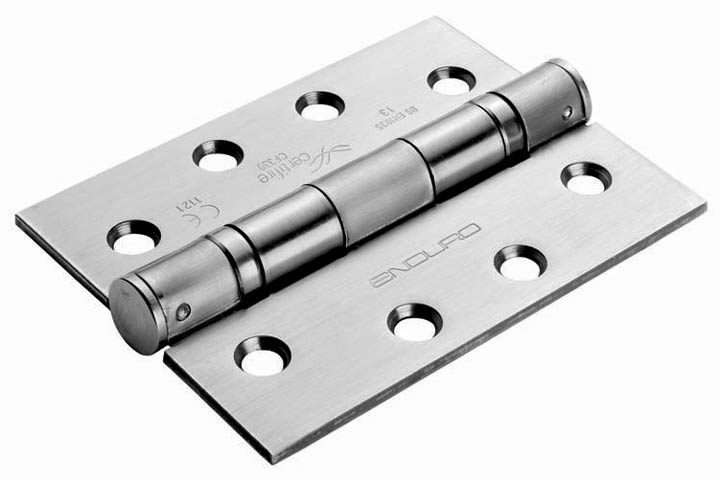
Click here to view our range of Door Hinges
Q. What types of hinges would I be most likely to use for hanging doors around my home?
A. The most common type of hinge used for hanging doors around the home is the "butt hinge". They are available in many different materials and finishes including brass, chrome, plain steel, stainless steel, aluminium and cast iron. Some "soft metal" hinges, such as brass, are available with stainless steel or phosphor bronze washers between the knuckle joints. This increases their life, especially where the door is regularly used. Butt hinges are available in a range of sizes depending on their application and corrosion resistance may also be a factor.
Q. What size hinges should I use to hang my door?
A. This primarily depends on the weight and size of the door you are hanging. Doors used in public buildings are generally larger and heavier than those used around the home and require stronger hinges to facilitate the extra weight. Internal doors around the home are generally hollow and in this situation using a pair of hinges will normally be sufficient, but for particularly heavy (over 20kg) or frequently used doors, fitting three hinges is recommended. Fitting a third hinge in the centre of the door helps to prevent warping and, in the case of fire and smoke doors, is a necessity and should always be fitted. The table below gives typical examples of door sizes/weights and suggests the appropriate class of hinge that will probably be required to hang the door when using three hinges. If two hinges are used you should step up one or two classes to compensate.
Hinge Classification Chart (using three hinges):
|
Door Type |
Estimated Door Size |
Estimated Door Weight |
Max. Yearly Operations |
Hinge Class (3 hinges) |
|
Light Wardrobe |
2040x626x40mm |
3 - 10 KG |
5000 |
1 |
|
Heavy Wardrobe |
2040x926x40mm |
10 - 17.5 KG |
5000 |
2 |
|
Medium Internal Doors |
2040x1012x40mm |
17.5 - 25 KG |
25000 |
3-4 |
|
Heavy Internal Doors |
2040x1012x40mm |
25 - 37.5 KG |
25000 |
4 |
|
Half Hour Fire Doors |
2040x826x44mm |
25 - 37.5 KG |
200000 |
5 |
|
One Hour Fire Doors |
2040x826x54mm |
37.5 - 72.5 KG |
500000 |
6-8 |
|
Light External Doors |
2040x907x40mm |
20 - 37.5 KG |
25000 |
3-4 |
|
Heavy External Doors |
2040x1002x44mm |
37.5 - 55 KG |
500000 |
6-7 |
|
Oversize Special External Doors |
2400x1200mm |
55 - 110 KG |
500000 |
7-9 |
Q. How do I describe the different hinge types and how are they measured?
A. The diagrams below show some of the various hinge types used around the home and the arrows indicate how these should be measured. This will assist you in asking for the correct type and specifying the size you need when ordering.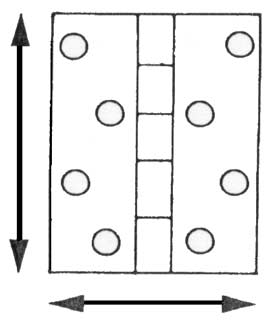
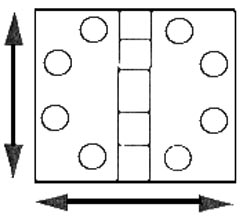
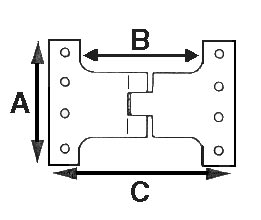
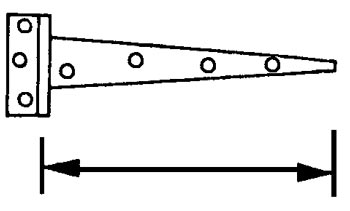
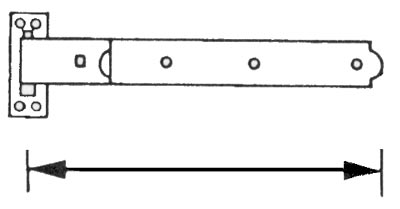
From left to right these hinge types are as follows:
1) Butt hinge (most common type for doors)
2) Projection hinge (used where the door opens up to 180° and clears a projection)
3) Parliament hinge (used where the door opens up to 180° and clears a projection)
4) Tee hinge (used on a garden gate)
5) Bands & Gudgeons (used on front drive gates or wooden garage doors)
Q. How should hinges be fixed?
A. The leaf or flap with the largest number of joints should be the side which is fixed to the door frame. The cut-outs should be of equal depth, square and plumb, ensuring that the pins are accurately aligned. Timber movement and shrinkage may mean that the hinges need to be re-aligned at a later date. The correct gauge and type of screw must be used and the cut-outs should be carefully made to provide clearance for the door to open.
Q. What type and size of screws should I use with my hinges?
A. You should always try to use screws that match the material of the hinge you are using, i.e. brass screws with brass hinges. If for example you use two different metals such as aluminium screws with brass hinges, the two dissimilar metals coming into contact will cause corrosion. This is because a small electric current passes from one metal to the other causing a chemical reaction. You should use countersunk screws when fitting your hinges and when fully tightened the head of the screw should be flush with the face of the hinge. Popular sizes for fixing butt hinges are 1.1/4" long by gauge 10 for 4" hinges and 1.1/4" long by gauge 8 for 3" hinges. It is beneficial to drill a small hole into the wood before fitting the screws to prevent the wood from splitting.
Q. I need my door to open a full 180°, what hinges should I use?
A. When a door is required to open up to 180° it usually needs to clear a projection such as the architrave around the door frame. In this situation you would use either "projection" or "parliament" hinges (difference explained below). The screw holes on these hinges are lined towards the edge of the hinge flap and so when fitted, the knuckle projects beyond the edge of the door. The further the projection, the greater the angle of opening achieved.
Q. What is the difference between "projection" and "parliament" hinges?
A. The difference between these two hinges is the knuckle size. Projection hinges are normally square in shape, i.e. 5"x5". Therefore, when fitted you would have the 5" length of knuckle projecting from your door. In the case of parliament hinges the knuckle size is reduced and therefore a lot less unsightly. The only drawback with using parliament hinges over projection hinges is the reduction in strength caused by the knuckle being cut away. You must ensure that you use the correct size hinge for your door weight.
Q. What type and size of hinges should I use to hang my wooden garden door or gate?
A. Garden doors or gates are usually hung using either "tee" hinges or "bands & gudgeons". Both these hinges have a long strap which is fixed across the face of the gate. The finish of these hinges is usually galvanised to help protect them against corrosion from rain and other weather conditions. Because gates are usually much higher and wider than ordinary doors, the strap fitted to the surface helps to support the extra weight. The size of hinge used depends on the width of the gate you are hanging, as a general guide we recommend the following: 1) For light domestic doors or wooden gates used infrequently the band width should be 33.3% of the width of the door. 2) For medium weight wooden doors or gates in commercial/industrial situations with moderate use the band width should be 50% of the width of the door.
Where any abnormally large wooden doors or particularly heavy wooden gates are to be fitted then technical advice should be sought. Any wooden door or gate measuring over two metres high but under three metres high must always be fitted with three hinges.
Q. What factors should I consider when choosing hinges?
A. As well as your door weight, height and thickness, there are other things you need to take into consideration when choosing hinges.
1) The material of your hinges: Does the finish match the rest of the furniture on your door?
2) Fire resisting requirements: Some washered hinges (with washers between the knuckle joints) are made using nylon washers. As the melting point of nylon is low, these would not be suitable for use on fire doors. Also some hinge materials such as aluminium have a low melting point. If the hinges are being used on fire doors you need to check they have a fire certificate.
3) Corrosion resisting requirements: It should be noted that bright zinc plating or electro brass plating are for internal use only and are unsuitable for situations where moisture comes into contact with the plated surface. Hot Spelter Galvanised or Sheradized finishes are the only plated finishes recommended for exterior use. Alternatively solid brass or stainless steel hinges may be more appropriate where there is moisture.
4) Angle of opening: Do you need projection or parliament hinges for an opening of up to 180°?
5) Handing: Some hinges i.e. rising butts which can be used to raise the door to clear a carpet, are handed. You need to know whether you need left or right hand.
6) Are there door closers fitted to the door? If so you need to increase the weight of the door by 20% when selecting your hinges. If the door closer has a back check action you need to double the door weight to ensure the hinges you choose are strong enough to overcome the extra pressure exerted on them by the resistance of the closer.
7) Finally you need to consider quality and price!
DISCLAIMER Door Furniture Direct makes every effort to ensure that the information contained in our FAQs is correct and accurate. We can however accept no responsibility for any errors or omissions or their subsequent effects. Indeed if you find any please let us know, we appreciate any advice or comments to improve these pages.
